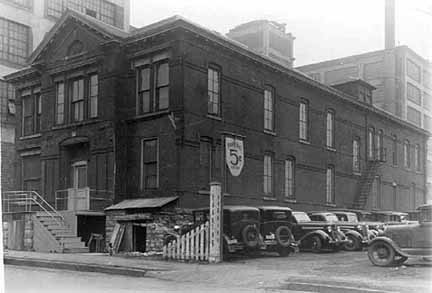Barefoot Boy Health Club
141 East Ninth Street, St. Paul, MN (1980?-1982)
| The St. Paul Relief Society in 1937. Image courtesy of the Minnesota Historical Society. |
In January of 1897, The New York Times reported on a freezing spell that hit the “Northwest.” Thermometers in the Twin Cities registered 25 below zero, “the warmest point in the whole section.”(1)
|
Relief societies came to the rescue of many urban households in these conditions. In Minnesota, these organizations frequently provided food, clothing, and fuel to poor households. In St. Paul, the St. Paul Relief Society saved the lives of countless St. Paulites for over 50 years. The small Catholic organization operated out of a small, 2-story structure on East 9th Street(3)—it predated its huge neighbor, the Shultze Shoe factory, by 40 years.
The St. Paul Relief Society was a distant memory by 1977, and its former headquarters had turned into a cheap rooming house. The old building’s rowdy occupants hassled customers of The Grand Finale in the former factory next door—this prompted the Finale’s owner, Chester Daxe, to purchase the building and “boot” its residents. At first, the owner attempted to act as a landlord for another group; this failed, and Daxe decided to follow the suit of other cities and open a gay bathhouse.(4)
The “Barefoot Boy Health Club opened after some remodeling of the building’s first and second floors (along with installation of the ubiquitous whirlpool). That basement apartment remained empty, save for a span of 4 months in 1980—Daxe and a few friends sponsored 11 gay refugees from Cuba following the infamous “Mariel Boatlift.” Business in the baths was never that strong; the venture closed and Daxe sold the building in 1982.(5)
(1)"Cold in the Northwest: From 25 to 40 Degrees Below Zero in Minnesota--Trains Stalled" The New York Times, 1/25/1897.
(2) Ibid.
(3) Castle, Henry Allen. History of St. Paul and Vicinity: A Chronicle of Progress and a Narrative Account of the Industries, Institutions, and People of the city and its Tributary Territory, Volume 2. St. Paul, The Lewis Publishing Company, 1912.
(4)Daxe, Chester. Correspondence with the author via email, 3/21/10
(5) Ibid.
Part of Minneapolis/St. Paul, MN: 100 Queer Places in Minnesota History, (1860-1969), (1969-2010)
